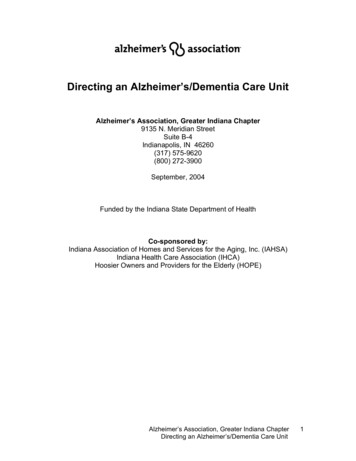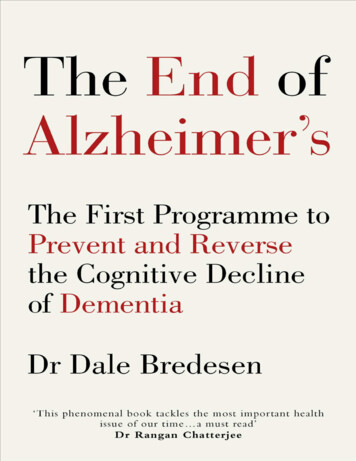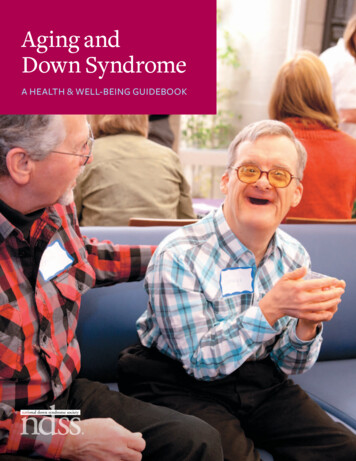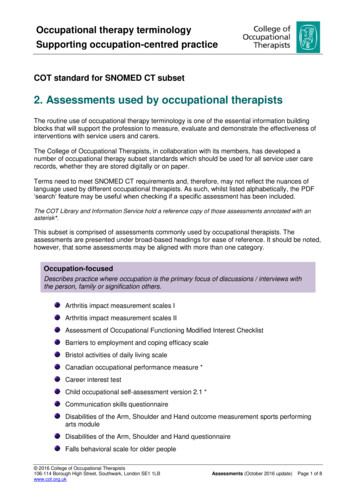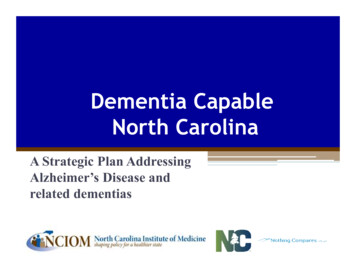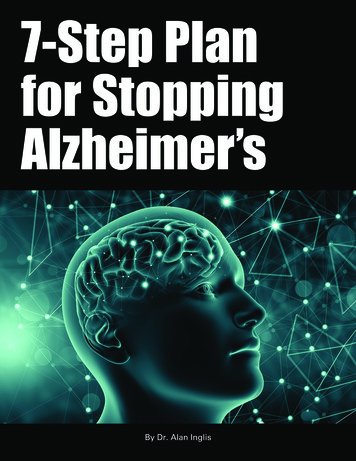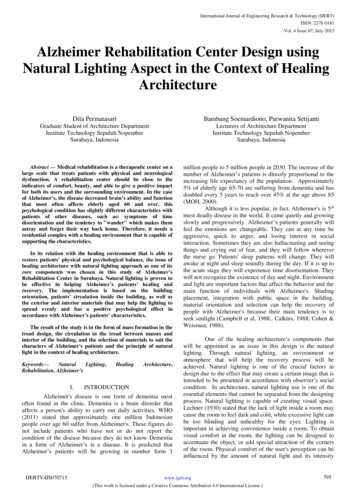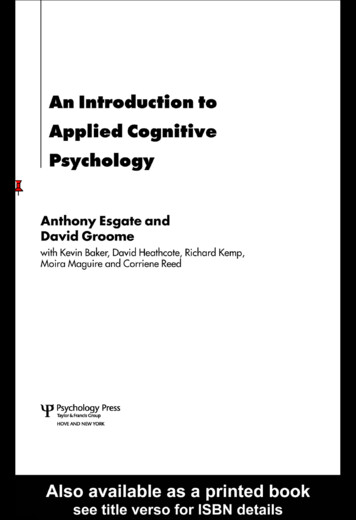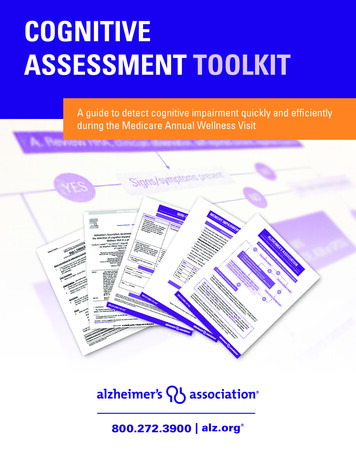
Transcription
COGNITIVEASSESSMENT TOOLKITA guide to detect cognitive impairment quickly and efficientlyduring the Medicare Annual Wellness Visit
TABLE OF CONTENTSOverview .3Medicare Annual Wellness Visit Algorithm for Assessment of Cognition .4General Practitioner Assessment of Cognition (GPCOG) .5Memory Impairment Screen (MIS) .7Mini-Cog .9TMShort Form of the Informant Questionnaire on Cognitive Decline in the Elderly (Short IQCODE) .11Eight-item Informant Interview to Differentiate Aging and Dementia (AD8) .14Alzheimer’s Association Recommendations for Operationalizing the Detection of CognitiveImpairment During the Medical Annual Wellness Visit in a Primary Care Setting .17800.272.3900 alz.org
OVERVIEWThe Alzheimer’s Association – dedicated to fueling the advancement of early detection and diagnosis ofdementia – has developed an easy-to-implement process to assess cognition during the Medicare AnnualWellness Visit. Developed by a group of clinical dementia experts, the recommended process outlined onpage 4 allows you to efficiently identify patients with probable cognitive impairment while giving you theflexibility to choose a cognitive assessment tool that works best for you and your patients.This Cognitive Assessment Toolkit contains: The Medicare Annual Wellness Visit Algorithm for Assessment of Cognition, incorporating patienthistory, clinician observations, and concerns expressed by the patient, family or caregiver Three validated patient assessment tools: the General Practitioner Assessment of Cognition (GPCOG),the Memory Impairment Screen (MIS) and the Mini-Cog . All tools:TM› Can be administered in 5 minutes or less› Are equal to or superior to the Mini-Mental State Exam (MMSE) for detecting dementia› Are easily administered by medical staff members who are not physicians› Are relatively free from educational, language and/or cultural bias Three validated informant assessment of patient tools: the Short Form of the Informant Questionnaireon Cognitive Decline in the Elderly (Short IQCODE), the Eight-item Informant Interview to DifferentiateAging and Dementia (AD8) and the GPCOG The “Alzheimer’s Association Recommendations for Operationalizing the Detection of CognitiveImpairment During the Medical Annual Wellness Visit in a Primary Care Setting,”as published in thejournal Alzheimer’s and Dementia.For more information on the detection, diagnosis and treatment of Alzheimer’s disease, as well as directaccess to patient and caregiver resources, please visit our Health Care Professionals and Alzheimer’s centerat alz.org/hcps.800.272.3900 alz.org
ALZHEIMER’S ASSOCIATION Medicare Annual Wellness Visit Algorithm for Assessment of CognitionA. Review HRA, clinician observation, self-reported concerns, responses to queriesYESSigns/symptoms presentNONOInformant available to confirmB.* Conduct brief structured assessment Patient Assessment: Mini-Cog or GPCOG or MIS Informant assessment of patient: Short IQCODE, AD8 or GPCOGYESFollow-up during subsequent AWVBrief assessment(s) triggers concerns: Patient: Mini-Cog 3 or GPCOG 5 (5-8 score is indeterminate without informant)or MIS 4 or Informant: Short IQCODE 3.38 or AD8 2 orGPCOG informant score 3 with patient score 8NOYESC. Refer OR Conduct full Dementia Evaluation* No one tool is recognized as the best brief assessment to determine if a full dementia evaluation isneeded. Some providers repeat patient assessment with an alternate tool (e.g., SLUMS, or MoCA)to confirm initial findings before referral or initiation of full dementia evaluation.AD8 Eight-item Informant Interview to Differentiate Aging and Dementia; AWV Annual WellnessVisit; GPCOG General Practitioner Assessment of Cognition; HRA Health Risk Assessment; MIS Memory Impairment Screen; MMSE Mini Mental Status Exam; MoCA Montreal CognitiveAssessment; SLUMS St. Louis University Mental Status Exam; Short IQCODE Short InformantQuestionnaire on Cognitive Decline in the ElderlyCordell CB, Borson S, Boustani M, Chodosh J, Reuben D, Verghese J, et al. Alzheimer’s Associationrecommendations for operationalizing the detection of cognitive impairment during the MedicareAnnual Wellness Visit in a primary care setting. Alzheimers Dement. 2013;9(2):141-150. Available 72.3900 alz.org
5Patient name:Date:GPCOG Screening TestStep 1: Patient ExaminationUnless specified, each question should only be asked onceName and Address for subsequent recall test1.“I am going to give you a name and address. After I have said it, I want you to repeatit. Remember this name and address because I am going to ask you to tell it to meagain in a few minutes: John Brown, 42 West Street, Kensington.” (Allow a maximumof 4 attempts).Time Orientation2.CorrectIncorrectWhat is the date? (exact only)Clock Drawing – use blank page3.Please mark in all the numbers to indicatethe hours of a clock (correct spacing required)4.Please mark in hands to show 10 minutes pasteleven o’clock (11.10)Information5.Can you tell me something that happened in the news recently?(Recently in the last week. If a general answer is given,eg “war”, “lot of rain”, ask for details. Only specific answer scores).Recall6.What was the name and address I asked you to rememberJohnBrown42West (St)Kensington(To get a total score, add the number of items answered correctlyTotal correct (score out of 9)/9If patient scores 9, no significant cognitive impairment and further testing not necessary.If patient scores 5-8, more information required. Proceed with Step 2, informant section.If patient scores 0-4, cognitive impairment is indicated. Conduct standard investigations. University of New South Wales as represented by the Dementia Collaborative Research Centre – Assessment and Better Care;Brodaty et al, JAGS 2002; 50:530-534
6Informant InterviewDate:Informant’s name:Informant’s relationship to patient, i.e. informant is the patient’s:These six questions ask how the patient is compared to when s/hewas well, say 5 – 10 years agoCompared to a few years ago:Yes Does the patient have more trouble remembering thingsthat have happened recently than s/he used to? Does he or she have more trouble recalling conversationsa few days later? When speaking, does the patient have more difficulty infinding the right word or tend to use the wrong wordsmore often? Is the patient less able to manage money and financialaffairs (e.g. paying bills, budgeting)? Is the patient less able to manage his or her medicationindependently? Does the patient need more assistance with transport(either private or public)?NoDon’tKnowN/A(If the patient has difficulties due only to physical problems, e.g bad leg, tick ‘no’)(To get a total score, add the number of items answered ‘no’, ‘don’t know’ or ‘N/A’)Total score (out of 6)If patient scores 0-3, cognitive impairment is indicated. Conduct standard investigations. University of New South Wales as represented by the Dementia Collaborative Research Centre – Assessment and Better Care;Brodaty et al, JAGS 2002; 50:530-534
7MEMORY IMPAIRMENT SCREEN (MIS)Instructions for Administration1. Show patient a sheet of paper with the 4 items to be recalled in 24-point or greater uppercaseletters (on other side), and ask patient to read the items aloud.2. Tell patient that each item belongs to a different category. Give a category cue and ask patient toindicate which of the words belongs in the stated category (eg, “Which one is the game?”). Allowup to 5 attempts. Failure to complete this task indicates possible cognitive impairment.3. When patient identifies all 4 words, remove the sheet of paper. Tell patient that he or she will beasked to remember the words in a few minutes.4. Engage patient in distractor activity for 2 to 3 minutes, such as counting to 20 and back, countingback from 100 by 7, spelling WORLD backwards.5. FREE RECALL — 2 points per word: Ask patient to state as many of the 4 words he or she canrecall. Allow at least 5 seconds per item for free recall. Continue to step 6 if no more words havebeen recalled for 10 seconds.6. CUED RECALL — 1 point per word: Read the appropriate category cue for each word not recalledduring free recall (eg, “What was the sageRed CrossOrganizationFree recall (2 pts.)ScoringThe maximum score for the MIS is 8. 5-8 No cognitive impairment 4 Possible cognitive impairmentCopyright 1999 Albert Einstein College of Medicine. All rights reserved.800.272.3900 alz.org Cued Recall (1 pts)
8WORD LISTCHECKERSSAUCERTELEGRAMRED CROSSCopyright 1999 Albert Einstein College of Medicine. All rights reserved.800.272.3900 alz.org
9Mini-Cog Instructions for Administration & ScoringID: Date:Step 1: Three Word RegistrationLook directly at person and say, “Please listen carefully. I am going to say three words that I want you to repeat backto me now and try to remember. The words are [select a list of words from the versions below]. Please say them forme now.” If the person is unable to repeat the words after three attempts, move on to Step 2 (clock drawing).The following and other word lists have been used in one or more clinical studies.1-3 For repeated administrations,use of an alternative word list is recommended.Version 1BananaSunriseChairVersion 2LeaderSeasonTableVersion 3VillageKitchenBabyVersion 4RiverNationFingerVersion 5CaptainGardenPictureVersion 6DaughterHeavenMountainStep 2: Clock DrawingSay: “Next, I want you to draw a clock for me. First, put in all of the numbers where they go.” When that is completed,say: “Now, set the hands to 10 past 11.”Use preprinted circle (see next page) for this exercise. Repeat instructions as needed as this is not a memory test.Move to Step 3 if the clock is not complete within three minutes.Step 3: Three Word RecallAsk the person to recall the three words you stated in Step 1. Say: “What were the three words I asked you toremember?” Record the word list version number and the person’s answers below.Word List Version:Person’s Answers:ScoringWord Recall:Clock Draw:(0-3 points)1 point for each word spontaneously recalled without cueing.(0 or 2 points)Normal clock 2 points. A normal clock has all numbers placed in the correctsequence and approximately correct position (e.g., 12, 3, 6 and 9 are in anchorpositions) with no missing or duplicate numbers. Hands are pointing to the 11and 2 (11:10). Hand length is not scored.Inability or refusal to draw a clock (abnormal) 0 points.Total score Word Recall score Clock Draw score.Total Score:(0-5 points)A cut point of 3 on the Mini-Cog has been validated for dementia screening,but many individuals with clinically meaningful cognitive impairment will scorehigher. When greater sensitivity is desired, a cut point of 4 is recommended asit may indicate a need for further evaluation of cognitive status.Mini-Cog S. Borson. All rights reserved. Reprinted with permission of the author solely for clinical and educational purposes.May not be modified or used for commercial, marketing, or research purposes without permission of the author (soob@uw.edu).v. 01.19.16
10Clock DrawingID: Date:References1.Borson S, Scanlan JM, Chen PJ et al. The Mini-Cog as a screen for dementia: Validation in a population-basedsample. J Am Geriatr Soc 2003;51:1451–1454.2.Borson S, Scanlan JM, Watanabe J et al. Improving identification of cognitive impairment in primary care. Int JGeriatr Psychiatry 2006;21: 349–355.3.Lessig M, Scanlan J et al. Time that tells: Critical clock-drawing errors for dementia screening. IntPsychogeriatr. 2008 June; 20(3): 459–470.4.Tsoi K, Chan J et al. Cognitive tests to detect dementia: A systematic review and meta-analysis. JAMA InternMed. 2015; E1-E9.5.McCarten J, Anderson P et al. Screening for cognitive impairment in an elderly veteran population:Acceptability and results using different versions of the Mini-Cog. J Am Geriatr Soc 2011; 59: 309-213.6.McCarten J, Anderson P et al. Finding dementia in primary care: The results of a clinical demonstrationproject. J Am Geriatr Soc 2012; 60: 210-217.7.Scanlan J & Borson S. The Mini-Cog: Receiver operating characteristics with the expert and naive raters. Int JGeriatr Psychiatry 2001; 16: 216-222.Mini-Cog S. Borson. All rights reserved. Reprinted with permission of the author solely for clinical and educational purposes.May not be modified or used for commercial, marketing, or research purposes without permission of the author (soob@uw.edu).v. 01.19.16
11Short Form of the Informant Questionnaire on CognitiveDecline in the Elderly (Short IQCODE)1by A. F. JormCentre for Mental Health ResearchThe Australian National UniversityCanberra, AustraliaThere is no copyright on the Short IQCODE. However, the author appreciates beingkept informed of research projects which make use of it.Note: As used in published studies, the IQCODE was preceded by questions to theinformant on the subject's sociodemographic characteristics and physical health.
12Now we want you to remember what your friend or relative was like 10 years ago andto compare it with what he/she is like now. 10 years ago was in 20 .* Below aresituations where this person has to use his/her memory or intelligence and we wantyou to indicate whether this has improved, stayed the same or got worse in thatsituation over the past 10 years. Note the importance of comparing his/her presentperformance with 10 years ago. So if 10 years ago this person always forgot wherehe/she had left things, and he/she still does, then this would be considered "Hasn'tchanged much". Please indicate the changes you have observed by circling theappropriate answer.Compared with 10 years ago how is this person at:123451. Remembering things aboutfamily and friends e.g.occupations, birthdays,addressesMuchimprovedA bitimprovedNot muchchangeA bitworseMuchworse2. Remembering things thathave happened recentlyMuchimprovedA bitimprovedNot muchchangeA bitworseMuchworse3. Recalling conversations afew days laterMuchimprovedA bitimprovedNot muchchangeA bitworseMuchworse4. Remembering his/heraddress and telephone numberMuchimprovedA bitimprovedNot muchchangeA bitworseMuchworse5. Remembering what day andmonth it isMuchimprovedA bitimprovedNot muchchangeA bitworseMuchworse6. Remembering where thingsare usually keptMuchimprovedA bitimprovedNot muchchangeA bitworseMuchworse7. Remembering where to findthings which have been put ina different place from usualMuchimprovedA bitimprovedNot muchchangeA bitworseMuchworse8. Knowing how to workfamiliar machines around thehouseMuchimprovedA bitimprovedNot muchchangeA bitworseMuchworse
139. Learning to use a newgadget or machine around thehouseMuchimprovedA bitimprovedNot muchchangeA bitworseMuchworse10. Learning new things ingeneralMuchimprovedA bitimprovedNot muchchangeA bitworseMuchworse11. Following a story in a book Muchimprovedor on TVA bitimprovedNot muchchangeA bitworseMuchworse12. Making decisions oneveryday mattersMuchimprovedA bitimprovedNot muchchangeA bitworseMuchworse13. Handling money forshoppingMuchimprovedA bitimprovedNot muchchangeA bitworseMuchworse14. Handling financial matterse.g. the pension, dealing withthe bankMuchimprovedA bitimprovedNot muchchangeA bitworseMuchworse15. Handling other everydayarithmetic problems e.g.knowing how much food tobuy, knowing how longbetween visits from family orfriendsMuchimprovedA bitimprovedNot muchchangeA bitworseMuchworse16. Using his/her intelligenceto understand what's going onand to reason things throughMuchimprovedA bitimprovedNot muchchangeA bitworseMuchworse*The original tool was published in 1994.The Alzheimer's Association updated the year 19 as published in the original tool to 20 .Tool Reference: Jorm AF. A short form of the Informant Questionnaire on Cognitive Decline in theElderly (IQCODE): development and cross-validation. Psychol Med 1994; 24: 145–153.
14AD8 Dementia Screening InterviewRemember, “Yes, a change” indicates thatthere has been a change in the last severalyears caused by cognitive (thinking andmemory) problems.Patient ID#:CS ID#:Date:YES,A changeNO,No changeN/A,Don’t know1. Problems with judgment (e.g.,problems making decisions, badfinancial decisions, problems withthinking)2. Less interest in hobbies/activities3. Repeats the same things over andover (questions, stories, orstatements)4. Trouble learning how to use a tool,appliance, or gadget (e.g., VCR,computer, microwave, remote control)5. Forgets correct month or year6. Trouble handling complicated financialaffairs (e.g., balancing checkbook,income taxes, paying bills)7. Trouble remembering appointments8. Daily problems with thinking and/ormemoryTOTAL AD8 SCOREAdapted from Galvin JE et al, The AD8, a brief informant interview to detect dementia, Neurology 2005:65:559-564Copyright 2005. The AD8 is a copyrighted instrument of the Alzheimer’s Disease Research Center, Washington University, St. Louis, Missouri.All Rights Reserved.
15The AD8 Administration and Scoring GuidelinesA spontaneous self-correction is allowed for all responses without counting as an error.The questions are given to the respondent on a clipboard for self–administration or can be readaloud to the respondent either in person or over the phone. It is preferable to administer the AD8to an informant, if available. If an informant is not available, the AD8 may be administered to thepatient.When administered to an informant, specifically ask the respondent to rate change in thepatient.When administered to the patient, specifically ask the patient to rate changes in his/her abilityfor each of the items, without attributing causality.If read aloud to the respondent, it is important for the clinician to carefully read the phrase asworded and give emphasis to note changes due to cognitive problems (not physical problems).There should be a one second delay between individual items.No timeframe for change is required.The final score is a sum of the number items marked “Yes, A change”.Interpretation of the AD8 (Adapted from Galvin JE et al, The AD8, a brief informant interview to detect dementia,Neurology 2005:65:559-564)A screening test in itself is insufficient to diagnose a dementing disorder. The AD8 is, however,quite sensitive to detecting early cognitive changes associated many common dementing illnessincluding Alzheimer disease, vascular dementia, Lewy body dementia and frontotemporaldementia.Scores in the impaired range (see below) indicate a need for further assessment. Scores in the“normal” range suggest that a dementing disorder is unlikely, but a very early disease processcannot be ruled out. More advanced assessment may be warranted in cases where otherobjective evidence of impairment exists.Based on clinical research findings from 995 individuals included in the development andvalidation samples, the following cut points are provided: 0 – 1: Normal cognition 2 or greater: Cognitive impairment is likely toReciever Operator Characteristics (ROC) curve for AD8be present1.00.8SensitivityAdministered to either the informant (preferable) or thepatient, the AD8 has the following properties: Sensitivity 84% Specificity 80% Positive Predictive Value 85% Negative Predictive Value 70% Area under the Curve: 0.908; 95%CI: 0.8880.9250.60.40.20.00.00.20.40.61 - Specificity0.81.0
16Copyright 2005. The Eight-item Informant Interview to Differentiate Aging and Dementia is acopyrighted instrument of Washington University, St. Louis, Missouri. All Rights Reserved.Permission StatementWashington University grants permission to use and reproduce the Eight-item Informant Interview toDifferentiate Aging and Dementia exactly as it appears in the PDF available here withoutmodification or editing of any kind solely for end user use in investigating dementia in clinical care orresearch in clinical care or research (the “Purpose”). For the avoidance of doubt, the Purpose doesnot include the (i) sale, distribution or transfer of the Eight-item Informant Interview to DifferentiateAging and Dementia or copies thereof for any consideration or commercial value; (ii) the creation ofany derivative works, including translations; and/or (iii) use of the Eight-item Informant Interview toDifferentiate Aging and Dementia as a marketing tool for the sale of any drug. All copies of the AD8shall include the following notice: “Reprinted with permission. Copyright 2005. The Eight-itemInformant Interview to Differentiate Aging and Dementia is a copyrighted instrument of WashingtonUniversity, St. Louis, Missouri. All Rights Reserved.” Please contact morrisj@abraxas.wustl.edu foruse of the Eight-item Informant Interview to Differentiate Aging and Dementia for any other intendedpurpose.
17Alzheimer’s & Dementia 9 (2013) 141–150Alzheimer’s Association recommendations for operationalizingthe detection of cognitive impairment during the Medicare AnnualWellness Visit in a primary care settingCyndy B. Cordella,*, Soo Borsonb,c, Malaz Boustanid,e,f, Joshua Chodoshg,h, David Reubenh,Joe Verghesei, William Thiesa, Leslie B. Friedj,k; for the Medicare Detectionof Cognitive Impairment WorkgroupaAlzheimer’s Association, Chicago, IL, USADepartment of Psychiatry and Behavioral Sciences, University of Washington School of Medicine, Seattle, WA, USAcMemory Disorders Clinic and Dementia Health Services, University of Washington School of Medicine, Seattle, WA, USAdIndiana University Center for Aging Research, Indianapolis, IN, USAeRegenstrief Institute, Inc., Indianapolis, IN, USAfDepartment of Medicine, Indiana University School of Medicine, Indianapolis, IN, USAgVeterans Administration Greater Los Angeles Healthcare System, Los Angeles, CA, USAhDivision of Geriatrics, David Geffen School of Medicine, University of California Los Angeles, Los Angeles, CA, USAiDepartment of Neurology, Albert Einstein College of Medicine, Bronx, NY, USAjAmerican Bar Association, Washington, DC, USAkAlzheimer’s Association Medicare Advocacy Project, Washington, DC, USAbAbstractThe Patient Protection and Affordable Care Act added a new Medicare benefit, the AnnualWellness Visit (AWV), effective January 1, 2011. The AWV requires an assessment to detect cognitive impairment. The Centers for Medicare and Medicaid Services (CMS) elected not to recommend a specific assessment tool because there is no single, universally accepted screen thatsatisfies all needs in the detection of cognitive impairment. To provide primary care physicianswith guidance on cognitive assessment during the AWV, and when referral or further testing isneeded, the Alzheimer’s Association convened a group of experts to develop recommendations.The resulting Alzheimer’s Association Medicare Annual Wellness Visit Algorithm for Assessmentof Cognition includes review of patient Health Risk Assessment (HRA) information, patient observation, unstructured queries during the AWV, and use of structured cognitive assessment toolsfor both patients and informants. Widespread implementation of this algorithm could be the firststep in reducing the prevalence of missed or delayed dementia diagnosis, thus allowing for betterhealthcare management and more favorable outcomes for affected patients and their families andcaregivers.Ó 2013 The Alzheimer’s Association. All rights reserved.Keywords:Annual Wellness Visit; AWV; Cognitive impairment; Assessment; Screen; Dementia; Alzheimer’s disease;Medicare; Algorithm; Patient Protection and Affordable Care Act1. IntroductionThe Patient Protection and Affordable Care Act of 2010added a new Medicare benefit, the Annual Wellness Visit*Corresponding author. Tel.: 312-335-5867. Fax: 866-699-1246.E-mail address: cyndy.cordell@alz.org(AWV), effective January 1, 2011. The AWV includesroutine measurements such as height, weight, and bloodpressure; a review of medical and family history; an assessment to detect cognitive impairment; and establishment ofa list of current medical providers, medications, and schedule for future preventive services. In addition, during the firstAWVonly, beneficiaries are to be screened for depression (if1552-5260/ - see front matter Ó 2013 The Alzheimer’s Association. All rights 011
142C.B. Cordell et al. / Alzheimer’s & Dementia 9 (2013) 141–150not completed under a separate Medicare benefit) and forfunctional difficulties using nationally recognized appropriate screening questions or standardized questionnaires. Although the U.S. Preventive Services Task Force (USPSTF)in 2003 concluded that there was insufficient published evidence of better clinical outcomes as a result of routinescreening for cognitive impairment in older adults, theTask Force recognized that the use of cognitive assessmenttools can increase the detection of cognitive impairment[1]. As per the Centers for Medicare and Medicaid Services(CMS) regulation, the AWV requires detection of cognitiveimpairment by “. assessment of an individual’s cognitivefunction by direct observation, with due consideration of information obtained by way of patient report, concerns raisedby family members, friends, caretakers, or others” [2]. During the public comment period, several organizations, including the Alzheimer’s Association, noted that the use ofa standardized tool for assessment of cognitive functionshould be part of the AWV.These comments are supported by a number of studiesshowing that cognitive impairment is unrecognized in27%–81% of affected patients in primary care [3–7]. Theuse of a brief, structured cognitive assessment toolcorrectly classifies patients with dementia or mildcognitive impairment (MCI) more often than spontaneousdetection by the patients’ own primary care physicians(83% vs 59%, respectively) [8].In response to concerns submitted during public comment,CMS elected not to recommend a specific tool for the finalAWV benefit because “There is no nationally recognizedscreening tool for the detection of cognitive impairments atthe present time.” [9]. However, CMS recognizes that without clarification, the full intended benefits of the AWV cognitive assessment may not be realized [10]. CMS is workingwith other governmental agencies (e.g., National Instituteson Aging) on recommendations for use of specific tools.Understanding that, under the present regulation, eachhealthcare provider who conducts an AWV would have todetermine how best to “detect cognitive impairment,” theAlzheimer’s Association convened the Medicare Detectionof Cognitive Impairment Workgroup to develop recommendations for operationalizing the cognitive assessment component in primary care settings. This workgroup wascomprised of geographically dispersed USA experts withpublished works in the field of detecting cognitive impairment during primary care visits. The focus on primary carewas deliberate, as most Medicare beneficiaries will receivetheir AWV in this setting.2. Guiding principles for recommendations2.1. Consensus on general principlesBased on their expertise, the workgroup agreed on the following general principles to guide the development of recommendations for cognitive assessment: Detection of cognitive impairment is a stepwise, iterative process. Informal observation alone by a physician is not sufficient (i.e., observation without a specific cognitiveevaluation). Detection of cognitive impairment can be enhanced byspecifically asking about changes in memory, language, and the ability to complete routine tasks. Although no single tool is recognized as the “gold standard” for detection of cognitive impairment, an initialstructured assessment should provide either a baselinefor cognitive surveillance or a trigger for further evaluation. Clinical staff can offer valuable observations of cognitive and functional changes in patients who are seenover time. Counseling before and after cognitive assessment is anessential component of any cognitive evaluation. Informants (family member, caregiver, etc.) can provide valuable information about the presence ofa change in cognition.2.2. Principles specific to the AWV The AWV requires the completion of a Health Risk Assessment (HRA) by the patient either before or duringthe visit. The HRA should be reviewed for any reportedsigns and symptoms indicative of possible dementia. The AWV will likely occur in a primary care setting.Tools for initial cognitive assessments should be brief(,5 min), appropriately validated, easily administeredby non-physician clinical staff, and available free ofcharge for use in a clinical setting. If further evaluation is indicated based on the results ofthe AWV, a more detailed evaluation of cognitionshould be scheduled for a follow-up visit in primarycare or through referral to a specialist.3. Review of available brief tools for use during the AWV3.1. Workgroup review processAlthough there is no single cognition assessment tool thatis considered to be the gold standard, there is a plethora oftools in the literature. A MEDLINE (PubMed) search conducted in October 2011, using the key words “screening ordetection of dementia or cognitive impairment,” yieldedover 500 publications. To narrow the search
FREE RECALL — 2 points per word: Ask patient to state as many of the 4 words he or she can recall. Allow at least 5 seconds per item for free recall. Continue to step 6 if no more words have been recalled for 10 seconds. 6. CUED RECALL — 1 point per word: Read the appropriate category cue for each word not recalled
